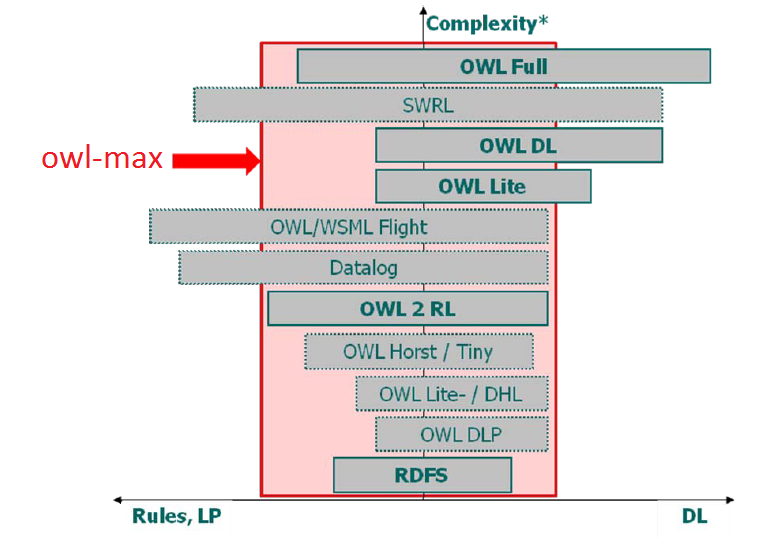3.1.5 Supported Semantics
OWLIM offers several pre-defined semantics by way of standard rule-sets (files), but can also be configured to use custom rule-sets with semantics better tuned to the particular domain. The required semantics can be specified through the rule-set for each specific repository instance. Applications, which do not need the complexity of the most expressive supported semantics, can choose one of the less complex, which will result in faster inference.
Pre-defined Rule-Sets
The pre-defined rule-sets are layered such that each one extends the preceding one. The following list is ordered by increasing expressivity:
empty: no reasoning, i.e. OWLIM operates as a plain RDF store;rdfs: supports standard RDFS semantics;owl-horst: OWL dialect close to OWL Horst; the differences are discussed below;owl-max: a combination of most of OWL-Lite with RDFS.
Furthermore, the OWL2 RL profile [5], is supported as follows:
owl2-rl-conf: Fully conformant except for D-Entailment, i.e. reasoning about data types;owl2-rl-reduced: As above, but with the troublesome prp-key rule removed (this rule causes serious scalability problems).
Custom Rule-Sets
OWLIM has an internal rule compiler that can be used to configure the TRREE with a custom set of inference rules and axioms. The user may define a custom rule-set in a *.pie file (e.g. MySemantics.pie). The easiest way to do this is to start modifying one of the .pie files that were used to build the pre-compiled rule-sets all pre-defined .pie files are included in the distribution. The syntax of the .pie files is easy to follow.
OWL Compliance
OWL compliance, OWLIM supports several OWL like dialects: OWL Horst [4], (owl-horst), OWL Max (owl-max) that covers most of OWL-Lite and RDFS, and OWL2 RL (owl2-rl-conf and owl2-rl- reduced).
With the owl-max rule-set, which is is represented in Figure 3, OWLIM supports the following semantics:
- full RDFS semantics without constraints or limitations, apart from the entailments related to typed literals (known as D-entailment). For instance, meta-classes (and any arbitrary mixture of class, property, and individual) can be combined with the supported OWL semantics;
- most of OWL-Lite;
- all of OWL DLP.
The differences between OWL Horst [4], and the OWL dialects supported by OWLIM (owl-horst and owl-max) can be summarized as follows:
- OWLIM does not provide the extended support for typed literals, introduced with the D*-entailment extension of the RDFS semantics. Although such support is conceptually clear and easy to implement, it is our understanding that the performance penalty is too high for most applications. One can easily implement the rules defined for this purpose by ter Horst and add them to a custom rule-set;
- There are no inconsistency rules by default;
- A few more OWL primitives are supported by OWLIM (rule-set
owl-max). These are listed in the OWLIM user guides; - There is extended support for schema-level (T-Box) reasoning in OWLIM.
Even though the concrete rules pre-defined in OWLIM differ from those defined in OWL Horst, the complexity and decidability results reported for R-entailment are relevant for TRREE and OWLIM. To put it more precisely, the rules in the owl-host rule-set do not introduce new B-Nodes, which means that R-entailment with respect to them takes polynomial time. In KR terms, this means that the owl-horst inference within OWLIM is tractable.
Inference using owl-horst is of a lesser complexity compared to other formalisms that combine DL formalisms with rules. In addition, it puts no constraints with respect to meta-modeling.
The correctness of the support for OWL semantics (for those primitives that are supported) is checked against the normative Positive- and Negative-entailment OWL test cases [6]. These tests are provided in the OWLIM distribution and documented in the OWLIM user guides.

Figure 3 - Owl-max and Other OWL Dialects
| Attachment | Size |
|---|---|
| owlmax.png | 207.68 KB |